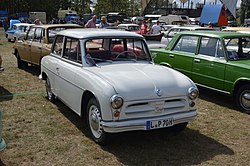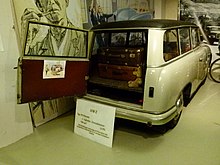EEZ P 70
| EEZ | |
|---|---|
|
AWZ P 70 sedan
|
|
| P 70 | |
| Production period: | 1955-1959 |
| Class : | Small car |
| Body versions : | Sedan , station wagon , coupé |
| Engines: |
Otto engine : 0.69 liters (22 PS / 16 kW) |
| Length: | 3740 mm |
| Width: | 1500 mm |
| Height: | 1480 mm |
| Wheelbase : | 2380 mm |
| Empty weight : | 800 kg |
| Previous model | IFA F8 |
| successor | Trabant P 50 |
The P 70 was a small car , which the IFA OPERATION VEB automobile factory Zwickau (as EEZ P 70 "Zwickau"), later VEB Sachsenring Zwickau automobile plants (as Sachsenring P 70 ) was prepared. The engine was produced in the Barkas factory . The designation P 70 stands for passenger cars with a displacement of 700 cm³. After the Chevrolet Corvette, the P 70 was one of the first production vehicles with a plastic body . Based on the IFA F8 , it was intended as an intermediate type for testing the new body material, but because of its too high price it could not be used for mass motorization in the GDR . This function was taken over by the cheaper Trabant , which was ready for series production in 1958 and was able to replace the P 70. This explains the very short construction time of the P 70 of only four years by GDR standards. Between 1955 and 1959, 36,151 sedan , coupé (approx. 1500 units) and station wagon models were produced. The vehicle was also exported in all its versions .
features
The basic design of the P 70 corresponds to the F8 , although it differs significantly from the latter due to the new pontoon body and the shorter wheelbase. It was delivered with a frame, a wooden skeleton body covered with thermoset parts and a slightly modified F8 engine. This engine was installed rotated 180 degrees compared to the IFA F8, so that it and the gearbox sat in front of the axle and the radiator was offset in height behind the engine. The output of the two-cylinder two- stroke gasoline engine has been increased by 2.5 hp to 22 hp with aluminum cylinder heads with centrally located spark plugs . Similar to the F8, the power was transmitted to the front axle via a multi-plate oil bath clutch, a chain and an unsynchronized three-speed gearbox with a lockable freewheel. The car also had a Dynastart system, i.e. a 12 V alternator that was seated directly on the engine shaft and also acted as a starter. The thermosiphon cooling without fan wheel, which is quite unusual in car construction , has been retained. With this very simple cooling system, there was a tendency for the cooling water to boil, especially when driving for long periods in 1st gear.
The body was a novelty: It consisted of a wooden frame that was planked with new types of thermoset shells specially developed at great expense. They consisted of a phenolic resin reinforced with short cotton fibers ( linters ) . With this construction, deep-drawable sheet steel, which was scarce in the GDR, could be dispensed with. The plastic also made it possible to reduce the vehicle weight and achieve a long service life. However, the roof of the station wagon, which was too large for the state of the art, was made of synthetic leather-covered plywood and the body skin of the coupé was made of steel. With the P 70, the outdated body of the F8 was to be replaced and the seating and space conditions improved. Because of its too expensive production and the not yet fully developed design, the P 70 was not considered suitable for mass motorization, rather the experience gained flowed into the parallel development of the Trabant.
The P 70 was initially spartan, which caused displeasure and faltering sales. At first it had neither movable door panes nor a trunk lid. In 1956 the vehicle received sliding windows in the driver and passenger door and some other improvements. The trunk of the limousine was only accessible via the passenger compartment, only the last copies produced had a trunk lid.
Models
In the spring of 1956, the P 70 station wagon went on sale in addition to the sedan. The roof of the station wagon, which was identical to the B-pillar of the sedan, was covered with synthetic leather. The large rear door was hinged on the side (left). It allowed good access to the large trunk. The size of the trunk made the P 70 station wagon very popular. The P 70 Coupé (from spring 1957) had a sheet steel body with a sporty design, which also attracted attention abroad. In addition to the streamlined shape, the aggressive radiator mouth, the chrome-framed air scoop on the bonnet and the retractable crank window together with the central strut also contributed to this. The sportiness was more external, because the coupé had the same engine as the other models despite its slightly higher weight.
Technical specifications
- Engine: two-cylinder three-channel two -stroke petrol engine with reverse scavenging
- Displacement: 690 cm³, stroke: 76 mm, bore: 76 mm
- Compression ratio: 6.8: 1
- Maximum power: 22 HP (16 kW) at 3500 min -1
- Max. Torque: 5.4 kpm (53 Nm) at 1900 min -1
- lockable freewheel on the crankshaft
- Cooling: water circulation cooling without pump ( thermosiphon cooling ) with water pipe cooler
- Carburettor : BVF flat-flow carburetor H 321-2
- Clutch : multi-plate oil bath clutch
- Gearbox: Block gearbox with built-in differential gear and axle drives
- three forward gears and one reverse gear, unsynchronized
- Translations:
- 1st gear: 3.44
- 2nd gear: 1.69
- 3rd gear: 1.00
- Reverse gear: 4.73
- Gear shift : crutch shift
- Front axle: independent suspension with semi-elliptic transverse leaf spring and wishbone
- hydraulic piston shock absorbers ( lever shock absorbers )
- Wheel drive via double cardan shafts
- Rear axle: Rigid axle on trailing arms with high-lying semi-elliptic transverse leaf spring ( floating axle )
- hydraulic piston shock absorbers (lever shock absorbers)
- Steering: rack and pinion steering with fabric disc and flutter brake
- Turning circle: ten meters
- Frame: box profile frame with two longitudinal and four cross members
-
Brakes :
- Footbrake: Innenbacken- Duplex - drum brakes , mechanically operated with cable
- Handbrake: acting mechanically on the rear wheels
- Wheels: disc wheels with 4-hole spacing 3.25 × 16 inches
- Tire size: 5.00–16
- Tank: 32 liters including a 4 liter reserve, can be switched using the fuel tap
- Consumption: approx. 8 liters of mixture 1:25 per 100 km
- Top speed: 90 km / h (Coupe 100 km / h)
- Electrical system:
- Ignition: Battery ignition with one breaker and one ignition coil per cylinder
- Spark plugs: M18 × 1.5, heat value 175
- Alternator: Dynastart 12 V, 250 W.
- Battery: 12 V, 56 Ah
- Headlights: 35/35 W, 12 V
- Radio (if available): Tube radio , fed by a chopper in the passenger footwell, mechanical waveband selection buttons
- Dimensions:
- Length: 3740 mm, width: 1500 mm, height: 1480 mm
- Ground clearance: 190 mm
- Wheelbase: 2380 mm
- Weight (1st value sedan, 2nd value station wagon, 3rd value coupé)
- permissible total weight: 1120 kg / 1150 kg / 1150 kg
- Empty weight: 800 kg / 830 kg / 875 kg
- Payload: 320 kg / 320 kg / 275 kg
literature
- Intermediate type P 70 with molded body. In: Motor Vehicle Technology 8/1955, pp. 257-259.
Web links
- More data and pictures about the P 70
- www.awz-p70.info
- The page for the P 70 Coupe
- www.trabiversum.de
Individual evidence
- ↑ Some improvements to the P 70. In: Motor vehicle technology 02/1961, p. 80.
- ↑ Criticism of our passenger cars. In: Motor Vehicle Technology 2/1956, pp. 70–72.
- ↑ Improvements to P 70. In: Motor vehicle technology 9/1956, pp. 348-349.
- ^ Motor vehicles at the Leipzig spring fair in 1956. In: Motor vehicle technology 3/1956, pp. 81–82.


